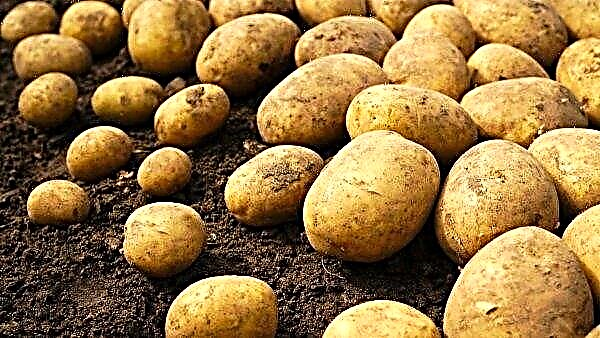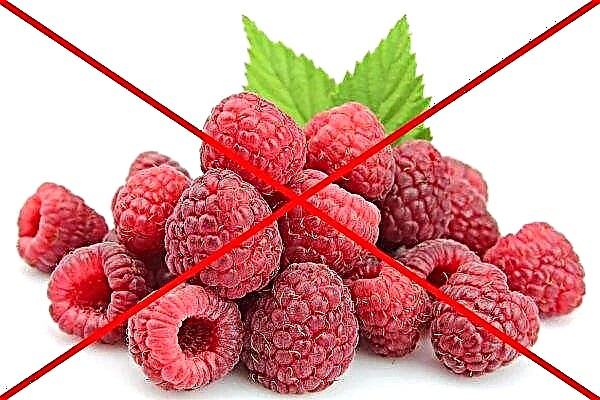Lactic acid is one of the most common drugs in rabbit breeding. It helps to cope with many diseases that domestic rabbits often suffer from. So what is this drug? For what, how and in what doses is it used?
Why do rabbits need lactic acid?
This tool is universal and almost indispensable for rabbit breeders. In veterinary medicine and agriculture, lactic acid is used to cope with the following ailments:
- enteritis;
- various kinds of abscesses;
- ulcers;
- gastritis;
- tympany;
- acute expansion of the stomach;
- flatulence;
- fungal and inflammatory processes on the dermis;
- with bloating.
Did you know? Due to the presence of a bifuriated uterus in a female rabbit, she can bear two litters at one time. They can be conceived at different times and from different partners.
This drug is used to disinfect animal feeders, equipment used in grooming, and rabbits. If lactic acid is part of the feed, it has a positive effect on the digestive processes in the animal’s body, favorably affects immunity, and accelerates the metabolism. Being a natural metabolite, it helps the body grow faster, reduces the negative impact that the use of roughage has on the rabbit's body. Moreover, this drug is completely absorbed by the body.
Pharmacological action and release form
Such a serum in appearance is almost transparent, with a slight yellowish tinge. The consistency resembles a syrup, with a slightly sour smell. This drug is produced as a result of anaerobic breakdown of carbohydrates. On pharmacy shelves, lactic acid for rabbits can be seen in glass or plastic containers of various sizes. This is usually an aqueous solution of 40% or 80% acid.
There are aqueous solutions with the following concentration: 1-2% for disinfection - for external use; 2-3% - with antiseptic, anti-fermentative and antispasmodic properties; 10% - with keratolytic effect; 30-40% - with cauterizing. In addition to water, lactic acid can be diluted with glycerol, ether or ordinary alcohol (can be used only for external use).
Did you know? In Australia, rabbits are considered the animals that cause the country the most damage from all the pests living there. In one of the Australian states since 2002, there is even a ban on keeping rabbits as pets. The penalty for violating this rule is about $ 30,000.
Instructions for use and dosage
If you purchase such a drug in a pharmacy, there are no instructions for using it specifically for rabbits in the package, so it is better to consult a veterinarian for advice. The rules for the use of serum in rabbit breeding are selected, given the many years of experience of veterinarians and rabbit breeders who know how often to feed rabbits with drugs or wash their wounds for speedy healing. How and in what quantities it is necessary to give lactic acid for treatment, prophylaxis of rabbit diseases or disinfection of wounds is described below.
For treatment
For the treatment of eared, a solution of lactic acid can be used both internally (to cope with diseases of internal organs, to prevent the appearance of some common diseases), and externally (to treat wounds or fight growths, warts). It is important to remember that for external use it is better to use a solution with a higher concentration of acid, and for internal use - with a lower one.
Important! Lactic acid can only be used to treat rabbits since they have reached the age of one and a half months.
Inside use
For the treatment of infectious diseases of the gastrointestinal tract, bloating, enteritis, gastritis, it is necessary to dilute lactic acid with ordinary drinking water in the following proportion: 2 tbsp. l on 10 l of water. Continue to give rabbits such water until complete recovery. To cope with severe flatulence, it is necessary to give the animal 4 ml of a 5% solution daily.
It is necessary to apply until all symptoms have completely disappeared. Fermentation during tympany is removed with a solution of 5% concentration. There is no specific dose to be used in such cases, however, it is recommended to add a few drops of acid to drinking water.
External application
Externally, the drug is used to soften keratinized growths or to disinfect wounds. For the first purpose, use a 10% solution, in the second case, serum 10-40% is suitable. You can use it daily until the problem disappears.
For prophylaxis
The use of a 2% lactic acid solution is an excellent way to prevent diseases of the gastrointestinal tract. It is necessary to add 4 ml of solution to water over 5 days. If you want to protect animals from bloating or infectious diseases, you need to dilute 2 tbsp. acid in one standard bucket of drinking water.
For disinfection
Using lactic acid, you can sanitize tools, drinkers, feeders, rabbit cages, feed or wounds on the skin. Disinfection of feed or equipment is carried out using a conventional spray gun, and wounds or external diseases with ordinary cotton wool. For disinfection of feed, a 3% solution in the following ratio is suitable: 0.5 ml. per 1 kg of feed. To cope with ulcers of the mucous membranes or skin will help 10-40% solution. You can burn neoplasms or keratinization with 20% serum, and corns or warts with a solution with 10-30% lactic acid. If you are disinfecting equipment, drinking bowls, cages, use a 20% solution. Pour the substance into the atomizer and spray evenly on all surfaces. After treatment, allow the room where the animals live to ventilate their feeders for at least 30 minutes.
You can burn neoplasms or keratinization with 20% serum, and corns or warts with a solution with 10-30% lactic acid. If you are disinfecting equipment, drinking bowls, cages, use a 20% solution. Pour the substance into the atomizer and spray evenly on all surfaces. After treatment, allow the room where the animals live to ventilate their feeders for at least 30 minutes.
Important! Scheduled disinfection of rabbitry is recommended every year, but the enclosure of a pregnant female should be processed 10 days before the rabbits appear and immediately after the offspring are taken away from her.
Contraindications
Despite the fact that such whey is a natural product that is almost harmless to your pets, experienced rabbit breeders recommend not to use this substance when:
- weeping ulcers;
- gastritis in the acute stage;
- increased acidity of gastric juice, blood or body tissues;
- renal failure.
Precautionary measures
Since this drug is non-toxic, all safety precautions come down to a few simple points:
- It is better to store the drug where children and animals do not reach it.
- Contact of the acid with the mucous membranes in the human body must be avoided. If such contact was, immediately flush the affected area with cold running water.

Storage conditions
In a sealed bottle at a temperature of -30 ° C to + 45 ° C, such serum can be stored for up to 10 years. In an open bottle, the shelf life is significantly reduced: the drug retains its beneficial properties only for a year and then at a temperature of -5 ° С to + 25 ° С.
Did you know? Rabbits have excellent vision: thanks to the convenient arrangement of the eyes, these animals can see, observing the territory by almost 360 °. In the wild, this ability often helps the rabbit not become a predator's prey. However, they still have two “blind spots”: behind the head and in front of the nose itself.
How can I replace lactic acid for rabbits?
There is no universal drug that has the same properties as lactic acid. But if you want to improve the well-being of pets, to prevent common infectious diseases or diseases of the gastrointestinal tract, use mineral supplements that will be an excellent addition to the daily diet of rabbits. It can be:
- iodine (water the animals in the morning with a 0.1% solution);
- bone meal (stir in feed 5 g per individual);
- fish meal (add to the feed 3 g per individual);
- salt (mix in the feed 1 g per day for one rabbit).
 Lactic acid for rabbits is an indispensable drug on the farm if your pets suffer from flatulence, bloating or warts. This drug is non-toxic, so it will not harm you or the rabbits. It is important to use it correctly on the recommendation of a veterinarian.
Lactic acid for rabbits is an indispensable drug on the farm if your pets suffer from flatulence, bloating or warts. This drug is non-toxic, so it will not harm you or the rabbits. It is important to use it correctly on the recommendation of a veterinarian.












